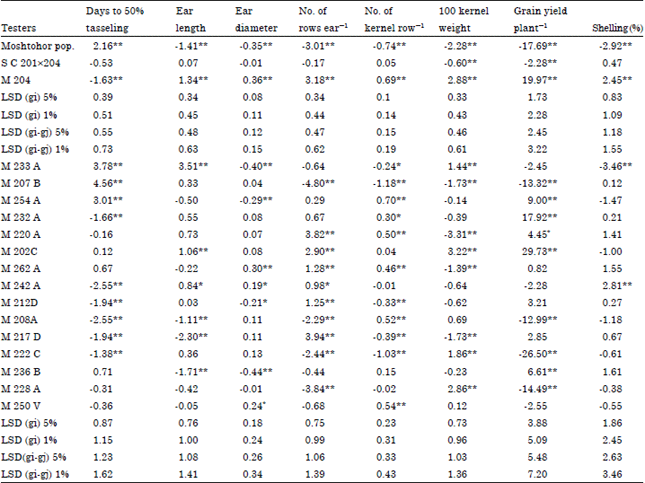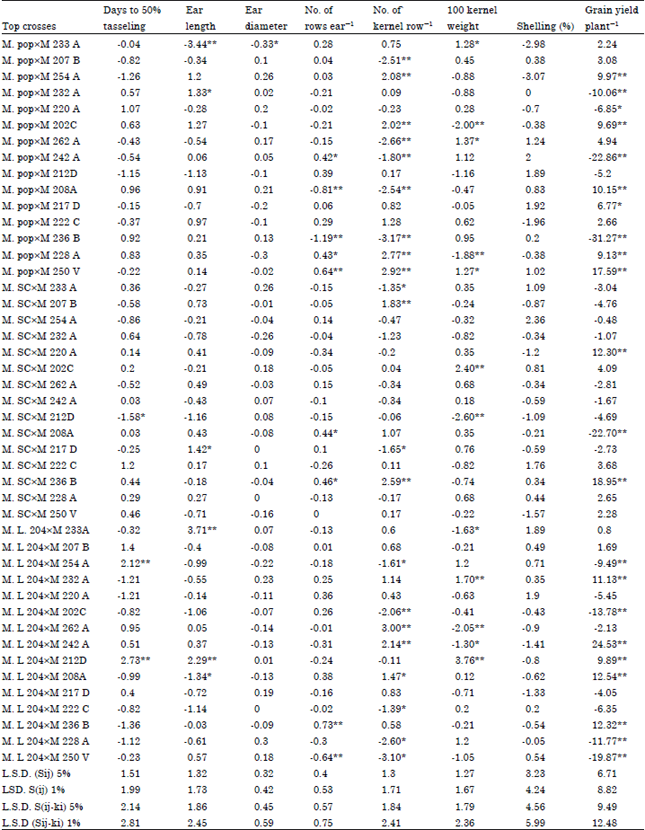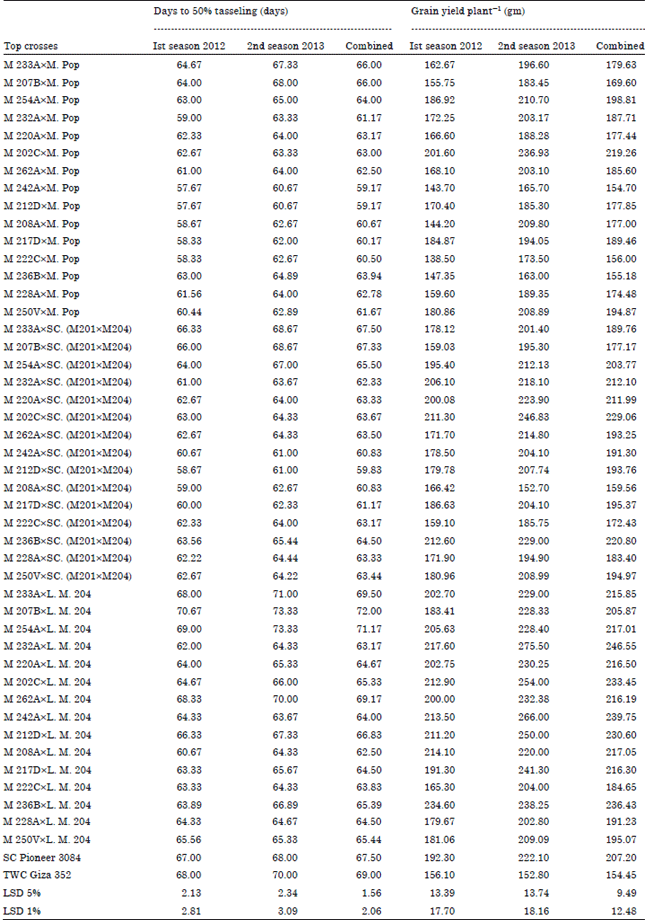ABSTRACT
Fifteen inbred lines and three testers of maize were crossed in line x tester scheme to study the combining ability effects for earliness, grain yield and yield components. A yield trial included the 45 top crosses, 15 inbred lines, 3 testers and two check hybrids S.C. Pioneer 3084 and T.W.C Giza 352. The experiment was conducted for three years at the Agricultural Research Station of the Faculty of Agriculture, Moshtohor, Benha University. The experimental design was randomized complete blocks with three replications. Mean squares due to crosses (C) inbred lines (L), testers (T) and line x tester (LxT) were significant for most studied traits for the combined analysis over two evaluation seasons. Significance of interaction variance for C, L, T and LxT with seasons on most studied traits was detected. δ2SCA played the major role in determining inheritance of all traits, revealing that the largest part of the total genetic variability associated with these traits was a result of non- additive gene action. The magnitude of the interaction of δ2SCAxyears (SY) was generally higher than for δ2GCA x SY. This indicates that non-additive type of gene action is more affected by SY than additive and additive x additive types of gene action. Inbred lines M L4, 8, 9, 10, 11 and L12 were reliable general combiners for earliness and M L3, 4, 5, 6 and L13 for grain yield plant-1. For earliness the top-cross M 212D x SC (M 201xM 204) gave the best Sij effects. Regarding grain yield plant-1, five SC between M L 204 and each of inbred lines M 232A, M 202C, M 242A, M 212D and M 236B as well as the two TWC M 202cxSC (201x204) and M 236BxSC (201x204) showed significantly and out yielded than check hybrid SC Pioneer 3084 by 18.99%, 12.67%, 15.71%, 11.29%, 14.11%, 10.55% and 6.56% in the combined analysis, respectively.
PDF Abstract XML References Citation
How to cite this article
DOI: 10.3923/ijpbg.2014.57.65
URL: https://scialert.net/abstract/?doi=ijpbg.2014.57.65
INTRODUCTION
The practical phase of maize breeding is based upon searching for elite inbred lines that possess higher combining ability to be used as parents for new superior hybrids or replace the currently used ones. The top cross method using broad and narrow base testers is the most common procedure for the evaluating process. A desirable tester may be defined as one that combines the greatest simplicity in use with the maximum information on the performance expected from the tested lines when used in other combinations or grown in other environments. No single tester can completely fulfill these requirements. The nature of testers to be used in the line x tester model for evaluating inbred lines is still unsolved problem. Therefore, the choice of a suitable tester is an important decision. Matzinger (1953) showed that a narrow genetic base tester contributes more to linextester interaction than does a heterogeneous one. Grogan and Zuber (1957) concluded that some single crosses were as equally effective as double crosses for measuring general combining ability. Davis (1927), Jenkins (1935) and Sprague (1939) suggested the method of early testing that is greatly affected by the nature of testers needed for efficient evaluation of inbred lines. The magnitude of genetic components for a certain trait would depend mainly upon the environmental fluctuations under which the breeding populations are tested. Therefore, much effort has been devoted by maize breeders to estimate the interactions between genetic components and environments.
The main objectives of the current study were to identify and assess superior inbred lines of maize, compare different testers for evaluating inbred lines, determined superior top crosses relative to check hybrid and estimate the combining ability of the testers and lines.
MATERIALS AND METHODS
Fifteen new inbred lines in S7 of yellow maize i.e. (Moshtohor) M. 233A (L1), M. 207B (L2), M 254A (L3), M 232A (L4), M 220A (L5), M 202C (L6), M 262A (L7), M 242A (L8), M 212D (L9), M 208A (L10), M 217D (L11), M 222C (L12), M 236B (L13), M 228A (L14) and M 250V (L15), all of which varied considerably in their characteristics, were used in this study. These inbred lines were crossed in the 2011 summer season with three different testers as follows: Moshtohor population open–pollination variety (M pop.), a promising high yield single cross M 201xM 204 and an elite of combining abilities inbred line M 204 generate 45 top crosses combinations in line x tester mating design. The top crosses with parents and two check hybrids single cross Pioneer 3084 and three way cross (TWC) Giza 352 were evaluated at the Agricultural Research Station of the Faculty of Agriculture, Moshtohor, Benha University in a randomized complete block design with three replications. The planing dates were 2nd June and 18th May in 2012 and 2013 seasons, respectively. Each plot consisted of one ridge 6-m long with a 70x25 cm plant density. The plots were irrigated eight times during the growing season and fertilized at rate of 286 kg N ha-1. The other cultural practices of maize growing were practiced. The following traits were noted on a random sample of 15 guarded plants in each plot; days to 50% tasseling, ear length, ear diameter, number of rows ear-1, number of kernels row-1, 100-kernel weight, grain yield plant-1 (adjusted to 15.5% moisture content) and shelling%. Analysis of variance was made for each of the two seasons then across both seasons after testing the homogeneity of error variances. Combining ability analysis was performed based on the procedure developed by Kempthorne (1957) over the two seasons.
RESULTS AND DISCUSSION
The analyses of variance for the studied traits are presented in Table 1. Mean squares due to years were highly significant for all traits, indicating overall differences between the two seasons. Highly significant crosses and their partitioning into inbred lines (L), testers (T) and linex tester (LxT) were significant for all studied traits of each season and across the two seasons except LxT for shelling%, revealing a wide range of variability among parental tester (males), lines (females) and that the lines performed differently according to the tester which they crossed. Significant interactions between crosses and year as well as between line and years were obtained for all traits except for the traits of days to 50% tasseling and ear diameter. This indicates that the crosses and lines behaved somewhat differently from one year to another. Mean squares for line x tester x years were significant for yield and yield components. This indicates that the studied top crosses responded differently to the summer seasons. These results are in accordance with those obtained by Sofi and Rather (2006), Abd El-Aal (2012) and El-Hosary and El-Gammal (2013). However, Amer and El-Shenawy (2007) who obtained significant interactions between environment, lines and testers regarding flowering and grain yield plant-1.
| Table 1: | Mean squares from ordinary analysis of variance and combining ability for the studied traits |
 | |
| *, **: Significance at 0.05 and 0.01 levels of probability, respectively | |
El-Morshidy et al. (2003) reported that testers were affected much more by environmental conditions than by line.
The estimates of the variance due to the general combining ability (δ2GCA) and the specific combining ability (δ2SCA) and their interactions with years (δ2GCAx year and δ2SCAx year), presented in Table 1, show that the δ2SCA played a major contribution in inheritance for total genetic variability associated with these attributes and was a result of non-additive action types. The results for grain yield plant-1 supports the findings by Sadek et al. (2002) who reported that δ2SCA was more important in the inheritance of grain yield plant-1. The magnitude of the interaction of δ2GCAx year was higher than that of δ2SCAx year for all of the studied traits. Consequently, additive gene effects seemed greatly affected by environment. These results are in agreement with the findings reported by Hefny (2010) and El-Badawy (2013) who noted that δ2SCA is more sensitive to environmental changes than δ2GCA.
Test of homogeneity revealed the validity of the combined analysis for the data of the two years. General combining ability effects (gi) calculated for each female and male (combined over two seasons) are presented in Table 2. High positive values would be of interest under all traits in question except that of days to 50% tasseling where high negative values would be useful from the breeder's point of view. The effects of gi for testers (males) showed that the inbred line M204 behaved as a good combiner for all traits. Earliness and high yielding if found in maize, would expand the opportunity for intensive cropping. Therefore, the male parent M204 could be an excellent parent in breeding programs towards releasing early and high yield potentiality of hybrid maize. On the other hand, the parental tester SC (201x204) expressed a highly significant negative results for days to 50% tasseling. The male parents Moshtohor pop. and SC(201x204) had undesirable gi effects for the remaining traits. Therefore, both male parents were of greatest interest and should be used as testers for evaluating the new inbred lines for these traits.
| Table 2: | General combining ability effects for testers and inbred lines for all studied traits in the combined analysis |
 | |
| *,** :Significance at 0.05 and 0.01 levels of probability, respectively | |
The parental females (inbred lines) M 232A (L4), M 242A (L8), M 212D (L9), M 208A (L10), M 217D (L11) and M 222C (L12) showed significant negative gi efects for days to 50% tesseling, M 233A (L1), M 202C (L6) and M 242A (L8) for ear length, M 262A (L7), M 242A (L8) for ear diameter, M 220A (L5), M 202C (L6), M 262A (L7), M 242A (L8), M 212D (L9) and M 217D (L11) for No. of kernels row-1, M 254A (L3), M 232A (L4), M 220A (L5), M 262A (L7), M 208A (L10) and M 250V (L15) for number of rows ear-1, M 233A (L1), M 202C (L6), M 222C (L12) and M 228A (L14) for 100-kernel weight, M 254A (L3), M 232A (L4), M 220A (L5), M 202C (L6) and M 236B (L13) for grain yield plant-1 and M 242A (L8) for shelling percentage had significant positive gi effects.
Specific Combining Ability effects (SCA) of 45 top cross are presented in Table 3. The greatest inter-and intra-allelic interaction as deduced from SCA effects were observed in top crosses: M 232AxM pop., M 217DxSC(201x204), M 207BxL M 204 and M 212DxL M 204 for ear length; M pop. with each of M 254A, M202c, M 228A and M250v; SC (201x204) with each of M 207B and M 236B; and M 204 with each of M 262A, M 242A and M 208A for the number of kernels row-1; M pop with each of M 242A, M 228A and M 250V; SC (201x204) with each of M 208A and M 236B; and M 204xM 236B for number of kernels row-1; M pop with each of M 233A and M 262A; SC (201x204)xM 202C; and L M 204 and each of M 232A and M 212D for the 100-kernel weight; and M pop and each of M 254A, M 202C, M 208A, M 217D, M 236B and M 250V; SC (201x204) and each of M 220A and M 236B and L M 204 with each of M 232 A, M 242A, M 212D, M 208A and M 236B for grain yield plant-1. These top-crosses might be of interest in breeding programs as most of them involved at least one good combiner for the concerned traits. These top crosses could be of interest to obtain synthetic varieties or produced inbred lines.
It could be concluded that testers of broad genetic base are more efficient than those of the narrow genetic base for evaluation of GCA inbred lines of maize. Among the material evaluated, the line Moshtohor 202A and M 232A gave the highest GCA effects for high yielding ability and that the top crosses M 242AxL M 204, M 236BxSC (201x204), M 250CxM pop. and M 236BxL M 204 appeared efficient and promising in improving grain yield.
Mean performance of 45 top crosses and two checks for days to 50% tasseling and grain yield plant-1 are presented in Table 4. For days to 50% tasseling, results showed that the most top crosses were earlier than the two check hybrids. The best top crosses for earliness were obtained by combinations between each of inbred lines; M. 208A, M. 232A, M. 222C, M. 242A, M. 228A and M. 202A with the three testers in both seasons and the combined analysis.
Mean grain yield plant-1 of 45 top crosses ranged from 138.5 (M. 222CxM pop.) to 234.6 (M. 236B x M 204) in the first season, 163 (M236BxM Pop.) to 275.50 (M232xM204) in the second season and 154.7 (242AxM Pop.) to 246.55 (M. 232xM 204) in the combined analysis. The five SC between M L 204 and each of inbred lines M 232A, M 202C, M 242A, M 212D and M 236B as well as the two TWC M 202cxSC (201x204) and M 236Bx SC (201x204) showed significantly and out yielded than check hybrid SC Pioneer 3084 by 18.99%, 12.67%, 15.71%, 11.29%, 14.11%, 10.55% and 6.56% in the combined analysis, respectively. All top crosses surpassed or insignificant differ than TW cross Giza 352. While, twenty seven crosses out yielded or insignificant than check hybrid Pioneer 3084. Hence, it could be concluded that these crosses offer possibility for improving grain yield of maize. These hybrids exhibited significant increase of one or more of traits contributing to grain yield. The fluctuation of hybrids from seasons to another was detected for grain yield plant-1.
| Table 3: | Specific combining ability, effects over both seasons (years) for all studied traits |
 | |
| *,**: Significance at 0.05 and 0.01 levels of probability, respectively | |
| Table 4: | Mean performance of the top crosses and check varieties in both seasons as well as the combined analysis for days to 50% tasseling and grain yield plant-1 |
 | |
CONCLUSION
From the above results it could be clear that non-additive genetic variance is considered to be the major source of total genetic variance responsible for the inheritance of all studied traits. The tester inbred line M 204 behaved as an excellent combiner for all traits. The Inbred lines M 242A, 232A, M. 212D and M. 236B had desirable and exhibited good general combiners for earliness and grain yield. The single cross M 204x242 A exhibited the highest SCA effects and suitable combinations for grain yield plant-1.
The five SC between ML 204 and each of inbred lines M 232A M 202C, M 242A, M 212D and M 236B as well as the two TWC M202CxSC (201x204) and M 236BxSC (201x204) showed significantly and out yielded than check hybrid SC Pioneer 3084 in the combined analysis.
REFERENCES
- El-Badawy, M.E.M., 2013. Heterosis and combining ability in maize using diallel crosses among seven new inbred lines. Asian J. Crop Sci., 5: 1-13.
CrossRefDirect Link - Grogan, C.O. and M.S. Zuber, 1957. A comparative study of top cross tester parents of maize. Agron. J., 49: 68-72.
CrossRef - Hefny, M., 2010. Genetic control of flowering traits, yield and its components in maize (Zea mays L.) at different sowing dates. Asian J. Crop Sci., 2: 236-249.
CrossRefDirect Link - Matzinger, D.F., 1953. Comparison of three types of testers for the evaluation of inbred lines of corn. Agron. J., 45: 493-495.
CrossRef - Sofi, P. and A.G. Rather, 2006. Genetic analysis of yield traits in local and CIMMYT inbred line crosses using line x tester analysis in maize (Zea mays L.). Asian J. Plant Sci., 5: 1039-1042.
CrossRefDirect Link - Sprague, G.F., 1939. An estimation of the number of top-crossed plants required for adequate representation of a corn variety. Agron. J., 31: 11-16.
CrossRef








